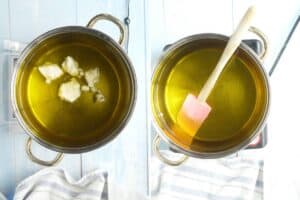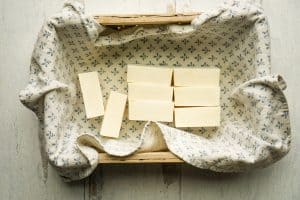Homemade Cleaning Soap
A coconut oil soap designed specifically for cleaning. Perfect for spot removal on upholstery, laundry stains, and use as all purpose cleaner.
Ingredients
- 30 ounces coconut oil
- 11 ounces water
- 5.52 ounces lye
- color and fragrance optional
Instructions
- Measure ingredients. Measure out the lye, coconut oil, and water in separate containers using a digital scale.
- Make lye water. Add the lye to the water, taking care to avoid breathing in any fumes. (NEVER add the water to the lye.) Stir with a butter knife to make sure all the lye dissolves. The solution will get very hot. Carefully set it aside to cool in a safe place.

- Melt coconut oil. Place the coconut oil into a pot and melt over medium-low heat on the stovetop. The oils must be completely melted and 130-140 degrees before proceeding. Once it has reached the temperature, remove it from the heat and allow it to cool in a safe place.

- Check temperatures. Check the temperature of your oil and lye after an hour or two. You can use a thermometer or feel the side of the containers with your hand. They should be comfortably warm, but not at all hot.
- Stick blend to trace. Pour the lye solution into the melted oil pot and blend using a stick blender. The soap solution is very caustic at this point and can cause burns. Make sure you are wearing gloves and goggles. Have everything ready before you start. Blend until your soap reaches trace. This means that when you drag your blender through the solution, it leaves a trace. If you lift up your stick and soap batter comes off of it, it will not immediately flow back in like a liquid, but will sit on top for just a second, like a thin batter.

- Pour into molds. As soon as trace is reached, immediately pour the batter into the molds. If you take too long, soap will start forming and hardening right in the pot. Put your mold out of the way somewhere to let the soap saponify (turn into soap). It will need to sit about 12-24 hours

- Cure. After the waiting period, turn the soap bars out and store them in a ventilated spot such as an old tea towel on top of a dresser. Allow to cure two weeks before using.

Video
Notes
Remember that this soap is not safe for skin. It is much too drying.
Can be used to rub onto stains, clean spots on the carpet, or rubbed onto a damp cloth for cleaning counters, appliances, or anything else. If you like homemade laundry detergent, you can shred for that as well!
New soapmakers, you need to be careful when working with lye. Read this first.